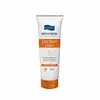What's inside
What's inside
 Key Ingredients
Key Ingredients

No key ingredients
 Benefits
Benefits

No benefits
 Concerns
Concerns

 Ingredients Side-by-side
Ingredients Side-by-side

Water
Skin ConditioningParaffinum Liquidum
EmollientIsopropyl Myristate
EmollientStearic Acid
CleansingDecyl Oleate
EmollientGlyceryl Stearate Se
EmulsifyingCetearyl Alcohol
EmollientTocopheryl Acetate
AntioxidantTriethanolamine
BufferingBHT
AntioxidantDisodium EDTA
Methylparaben
PreservativeImidazolidinyl Urea
PreservativePropylparaben
PreservativeParfum
MaskingBenzyl Salicylate
PerfumingButylphenyl Methylpropional
PerfumingHydroxycitronellal
PerfumingLinalool
PerfumingWater, Paraffinum Liquidum, Isopropyl Myristate, Stearic Acid, Decyl Oleate, Glyceryl Stearate Se, Cetearyl Alcohol, Tocopheryl Acetate, Triethanolamine, BHT, Disodium EDTA, Methylparaben, Imidazolidinyl Urea, Propylparaben, Parfum, Benzyl Salicylate, Butylphenyl Methylpropional, Hydroxycitronellal, Linalool
Water
Skin ConditioningGlycerin
HumectantStearic Acid
CleansingIsopropyl Palmitate
EmollientGlycol Stearate
EmollientPEG-100 Stearate
Dimethicone
EmollientParaffinum Liquidum
EmollientGlyceryl Stearate
EmollientPetrolatum
EmollientCetyl Alcohol
EmollientPhenoxyethanol
PreservativeMethylparaben
PreservativeAcrylates/C10-30 Alkyl Acrylate Crosspolymer
Emulsion StabilisingTriethanolamine
BufferingPropylparaben
PreservativeStearamide Amp
Disodium EDTA
Hydroxystearic Acid
CleansingWater, Glycerin, Stearic Acid, Isopropyl Palmitate, Glycol Stearate, PEG-100 Stearate, Dimethicone, Paraffinum Liquidum, Glyceryl Stearate, Petrolatum, Cetyl Alcohol, Phenoxyethanol, Methylparaben, Acrylates/C10-30 Alkyl Acrylate Crosspolymer, Triethanolamine, Propylparaben, Stearamide Amp, Disodium EDTA, Hydroxystearic Acid
Ingredients Explained
These ingredients are found in both products.
Ingredients higher up in an ingredient list are typically present in a larger amount.
Disodium EDTA plays a role in making products more stable by aiding other preservatives.
It is a chelating agent, meaning it neutralizes metal ions that may be found in a product.
Disodium EDTA is a salt of edetic acid and is found to be safe in cosmetic ingredients.
Learn more about Disodium EDTAMethylparaben is a preservative and is a paraben. It is used to prevent the growth of fungus, mold, and other harmful bacteria. Parabens are chemicals used as preservatives in both cosmetics and food.
Methylparaben can be synthetically created. It can also be found naturally in some fruits, such as blueberries.
Oftentimes, Methylparaben is combined with other parabens to help increase the shelf life.
The safety of Methylparaben is currently being studied. While ongoing studies are looking into the safety of parabens, the results have been very mixed. Some studies have not found Methylparaben to be harmful.
Learn more about MethylparabenParaffinum Liquidum is also known as liquid paraffin. It is a type of highly refined mineral oil.
Like other oils, Paraffinum Liquidum has emollient properties. Emollients help soothe and soften the skin. By creating a barrier to trap moisture within, emollients help keep your skin hydrated.
Paraffinum Liquidum does not irritate the skin and is non-comedogenic.
Learn more about Paraffinum LiquidumPropylparaben is a preservative and is a paraben with antifungal and antimicrobial properties.
This ingredient can be naturally found in plants and insects, but most of it is synthetically manufactured for human use. In cosmetics, it is usually created by reacting para-aminobenzoic acid and propanol (an alcohol).
You can usually find this ingredient in water-based products.
Parabens have come under controversy due to the claim they are hormone disruptors. Studies show conflicting results. We recommend speaking with a professional if you have any concerns.
Propylparaben is commonly found in food, medicine, and cosmetics.
Learn more about PropylparabenStearic Acid is a fatty acid. It is an emollient, emulsifier, and texture enhancer.
As an emollient, stearic acid helps soften skin. It aids the skin's protective barrier by preventing water loss. It also provides a gentle cleansing effect without stripping away natural oils.
Stearic acid may also be used to enhance the texture of products. It can add volume and stabilize ingredients such as water and oil. This can help water and oil ingredients from separating.
Sources of stearic acid include animal or vegetable fats/oils such as coconut or shea. It can be naturally found in butter, cocoa butter, shea butter, vegetable fats, and animal tallow.
This ingredient may not be Malassezia folliculitis, or fungal-acne safe.
Learn more about Stearic AcidTriethanolamine is an emulsifier and pH adjuster. It is created using ethylene oxide and ammonia. This gives Triethanolamine a nitrogen core and a similar scent to ammonia.
As an emulsifier, it prevents ingredients from separating and enhances texture by adding volume to a product.
PH adjusters are common in cosmetic products. The pH of a product can affect the effectiveness of other ingredients. A product with a high pH may also irritate the skin.
Learn more about TriethanolamineWater. It's the most common cosmetic ingredient of all. You'll usually see it at the top of ingredient lists, meaning that it makes up the largest part of the product.
So why is it so popular? Water most often acts as a solvent - this means that it helps dissolve other ingredients into the formulation.
You'll also recognize water as that liquid we all need to stay alive. If you see this, drink a glass of water. Stay hydrated!
Learn more about Water